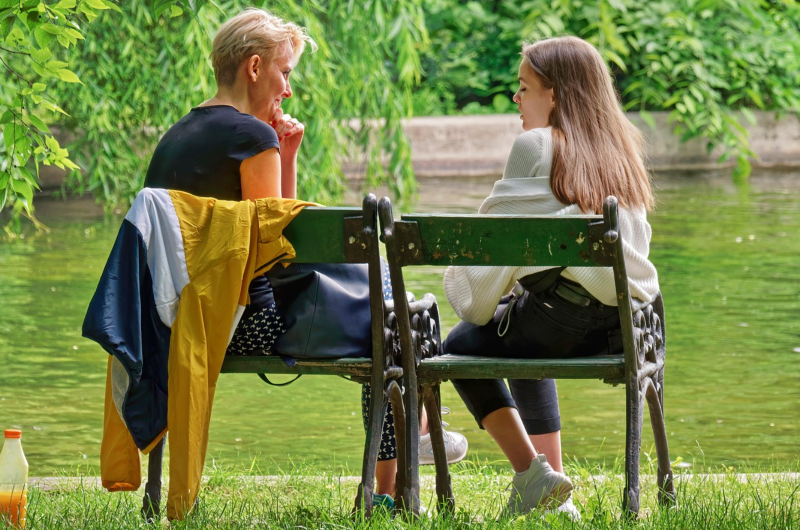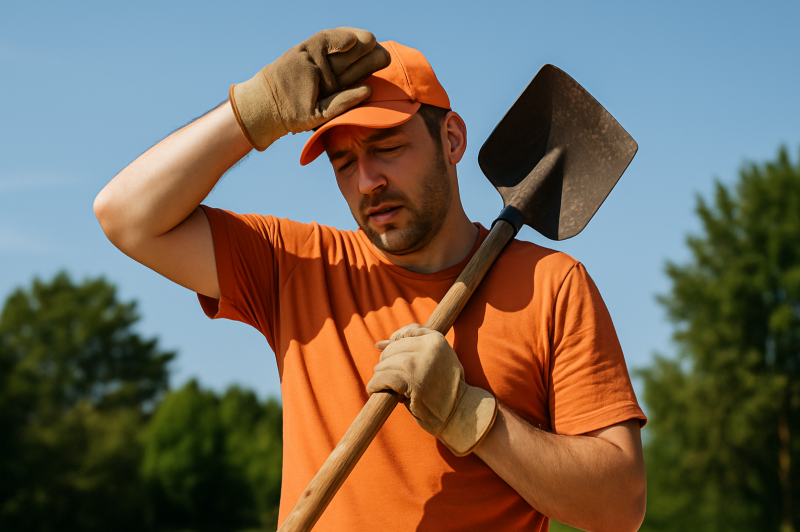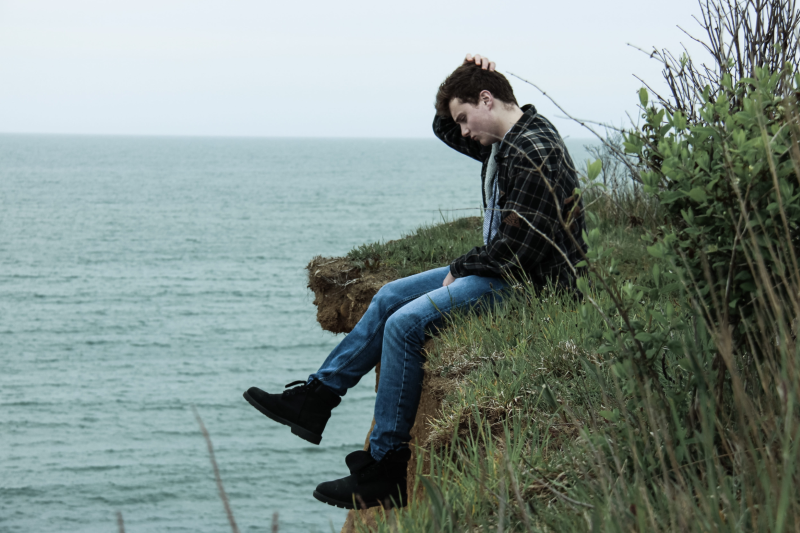
Nature offers solace for a man living with depression—and a lesson in acceptance for his anxious partner.

By Jana Richman
Author
In a dark time, the eye begins to see.
Theodore Roethke
It slips in quietly. A hint of terseness marks his voice, an opaque film covers his blue eyes, his face flushes and its lines deepen. His 6’4” frame droops toward the floor as if he’s ashamed to drape his sorry self over it, and he tries to creep from the room unnoticed. It hurts him to be seen.
We share the only bed in our house, but he curls close to the edge, his face in the moonlight twisted and consternated. I want to reach out with a soothing touch, but I have learned not to. When he is deep in his dark world, a simple touch will send a startle response through his bones. He will burst from the bed as if facing a knife- wielding attacker and his wild eyes will be locked on me.
When I wake in the morning to find his side of the bed cold, I search for signs: a spoon in the sink indicates coffee was made; a creaking floor in his upstairs office indicates movement. From the signs, I can measure the depth of his depression and the probable length of its stay. No signs at all, and I feel as if I’ve been stalked into a dead-end alley.
I once believed myself capable of empathetic greatness, a belief that’s been gutted and redesigned like a nineteenth-century farmhouse. The crumbling bricks still hold, but the interior structure bears little resemblance to the original.
Steve was fifty when we met; I was forty-eight. Our future held no golden wedding anniversary; silver was dubious. Such reckonings cut short the discovery period of romance enjoyed by the young. We acknowledged our love for each other, and, almost in the same breath, we acknowledged our impediments: Steve’s depression, my anxiety.
Having anxiety in our anxious culture is like wearing a white T-shirt—it’s not conspicuous—so I had minimal awareness of its scope. And being wholly naïve about depression, I shrugged it off in the name of love. With less caution than warranted, Steve and I joined hands and stepped into the abyss.
Anxiety and depression share commonalities. In our case, the emotional memories of each are decades—maybe generations—old, with no faces, no bodies, no specific points of origin. These similarities generate compassion between us but not necessarily understanding. And distinct differences make us ill-suited for sharing a life.
Anxiety gushes out, soliciting reassurance and relief; depression pulls in and sets up barriers. Anxious people want to process, often in a desperate, frenetic way. But insisting that a depressed person process his current state is worse than futile; it is merciless. Working together, depression and anxiety construct a near impermeable trap. When I sense Steve’s depression, I churn in angst. When Steve senses my anxiety, he drops deeper.
Steve’s depression is episodic, triggered in a moment that takes him down. And in that moment, life is brusquely shifted, shut down for an indefinable period. When I first saw it, although I had been forewarned, I had no idea what I was seeing. The shift in his physical appearance alone pulled me up short, and the abrupt change in personality seemed like a subterfuge. And for many years I treated it as such, demanding that he stop and explain himself.
He retreats into his impenetrable misery behind the closed door of his office. I walk to keep my body occupied while my emotions lurch from confusion to sadness to anger to desperation. I return to a quiet house, no traces of movement. I search the bookshelves and Internet for comfort. So much advice—all of it familiar, none of it useful.
Two days go by without verification of life. I stew and listen and watch. I dissect the days and hours leading up to the moment it slithered in. I pinpoint the trigger and rewrite the script. I chant a whispered mantra: This will end. But I worry that it won’t end, that we’ll be here on our respective sides of a cheap, hollow door three weeks, three months, three years from now.
On the third day, the door opens and I jump to attention. He slouches down the stairs without making eye contact, looking ten years older than he looked four days prior. I offer to make soup, I suggest a hike, I extend bookshelf advice in a cheerful voice tinged with urgency. I speak to him as if he doesn’t understand his own mind. He goes back upstairs and shuts the door.
Steve embodies light and dark in their extremities. The dark runs deep and murky, but radical light runs parallel. I fear the dark will snuff out the light and destroy him, destroy us. He assures me that will never happen, and like a religious skeptic teetering on the edges, I work to keep the faith. I want to pry him apart, separate light from dark. I want the model with the personalized options, not the package deal, but his GPS is already installed. Ripping it out would leave him lighter, yes, but also deformed, shrunken, misshapen. Much of his beauty comes out of the shadow. His gentleness, his patience, his wisdom, his passion—all flow from having dwelt in the tender place of despair. I deeply understand the truth of this. Still, I want it to be easier—for him, yes, but mostly for me. He knows this darkness, and he oddly draws strength from its familiarity, as if it constitutes some sort of sacred ritual. I cower in its presence.
On the fourth day, I wake to find the office door open and him gone. I breathe a sigh of relief for a morning without his dark presence and say a small prayer to the gods he worships: redrock canyons and sagebrush flats. He has gone to the desert.
I walk out to the garage to see what’s not there: a cot, a sleeping bag, a five-gallon water jug. All good signs. He will spend nights under a dark sky, and when the sun rouses him, he will walk between redrock walls, bumping against them in his rawness. He will find a flat run of slickrock to lie upon, and he will stay until desert light finds a fissure in his constructed shield. Then he’ll come back to me.
Shortly after I met him, Steve said something that would become a refrain in our relationship: I need to go to the desert. We met in Tucson and lived in Salt Lake City, so technically we had always been in a desert, but that’s not what he meant. He sought a desert free of humans and their debris, full of light, where he could dwell undisturbed for an extended period of time.
Having grown up in Utah’s West Desert, I, too, have an appreciation for such places, but I initially thought him prone to hyperbole. Imprudently clinging to the popular view that all power lies within, I equated Steve’s stated need to the exaggerated notions of a teenager needing a new iPhone. But after twelve years of inadvertent research, my flippancy has waned.
On our wedding day, Steve promised to always rescue himself—it was written into the vows. In my most anxious moments, I have extracted the promise from him again and again, but the last time I did was in the autumn of 2013, which was when I, at long last, understood that he has only one fail-safe rescue: the desert.
It was our worst year together, high anxiety and deep depression, each tightening the knots of the other. We futilely tugged from opposite ends for eight months. In the fall, I suggested a weekend backpack on the Escalante River, and he nodded his agreement. But on the day we were supposed to leave, he couldn’t rally the energy to abide my company, having, no doubt, sensed my desperate reach for relief. After he shut the upstairs door, I sat amid the mess of freeze-dried food packets and cried. Then I packed.
I would like to say I left the house quietly, but I didn’t. I breached the sanctity of the closed door and made a dramatic, sobbing speech and exit. I no longer remember the words, but I remember the cruelty behind them. I’m sure I demanded some sort of promise or explanation that he could not possibly give. I remember his horrified face as I loaded my pain onto his.
I drove fifteen miles to the trailhead shaking with the kind of generalized rage that has no receptacle. Only after hoisting the pack and splashing through the knee-high, sun-warmed water for the first of many river crossings did I acknowledge that I had never backpacked alone, never spent a night out there by myself. It was an easy three-mile hike upriver to the Sand Creek confluence where I planned to camp, and the physical risk was minimal. But the sun drops early in the river gorge, and the long stretch of night ahead played on my nerves.
Righteous indignation propelled me forward, a feeling of something having been thrust upon me that I did not deserve. I slogged through deep sand, stumbled often, and expended a great deal of energy to gain little ground. Had I lifted my eyes from the trail, I might have been awed by Escalante Natural Bridge, a sturdy, flat-topped, deep red and brown arch that spans a side canyon like a train trestle. Had I lifted my eyes, my heart may have been lightened—or at least distracted—by the Indian domicile ruins on a ledge next to a wall of seven-hundred-year-old petroglyphs. But I did not lift my eyes. I rounded the bend in the river that alerted me to the confluence without acknowledging the painted red snake on the slickrock I skirted, without pondering its symbolism, although it may have been as relevant to me as it was to its creator. Rebirth? Resurrection? Initiation?
I dropped into a hole that brought the river to my upper thighs before climbing the sandy, steep bank on hands and knees. Knowing that seeking ant-free ground would be futile, I pitched my tent among the small creatures under a cluster of cottonwoods and cooked dinner before the sun went down. Then I crossed the cold, shin-high waters of Sand Creek and set my Therm-a-Rest chair on a partially dry, flat rock in the last splice of sunlight. I faced a soaring, creamsicle-orange wall with white streaks—as if someone had poured a bucket of Clorox from the top every few yards—and waited for darkness to descend. But it never did.
The wall, a magnificent domed rock bestowed with runs of creamy smoothness from calving, was the last in the canyon to lose light. It presided over the celestial ceremony of sundown—quieting the whistling birds, hushing the croaking ravens, piloting a change of temperature and a kettle of turkey vultures on a gust. As the diurnal fell silent, whispering grasses and rustling river willows filled the void. On my right, a tranquil spring wallpapered the Navajo sandstone with ivy, ferns, and columbine before trickling through a crack in many straggling fountains at mouth level and leaving the rocks below it covered in spongy lime-green moss.
Sand Creek approached me from behind a grassy bend, ran over slickrock and sand, bumped against, and parted for, volcanic boulders, passed me close enough to splash my left arm and leg, gathered spring water from the right, and then disappeared around an eastern bend to meet the river. Near and distant, peach and rose, honey and ginger colored walls, polished to a high sheen by desert varnish and pockmarked by wind and water, surrounded me on all sides, sharing the warmth of the sun.
As the reigning wall lost its light, the hanging garden lost its shimmer in the shadows, the creek gurgled, the spring trickled, and a warm breeze blew. I sat very still, every sense heightened—and pacified. Tranquility edged in like rainwater through a crack in sandstone. After a while, I could no longer discern my feet on the rock or sand on my skin. The place integrated my presence as if I were natural to it, and I felt the whole of it.
I sat. I had been breathing shallowly for many months, holding myself together with a pinched brow and rigid muscles. I breathed. My shoulders fell. Fear and dread oozed from my body and was cleanly washed away by Sand Creek—as if it were no problem at all—and delivered to the river where it would flow out of reach. Shhhh, the place whispered. Be still.
Moonlight climbed sandstone walls bringing with it the thought of Steve’s refrain: I need to go to the desert. I had heard the urgency in his voice, but I refused to hear the truth in his words. I had scoffed at the idea that a place could do for him what I could not—that a place could hold him, soothe him, reach into the depths of that darkness and pull him out. And now, here I sat, held by the place. And here was the thing that left me dumbfounded: the place had been here all along. Through many months of homebound angst, through my desperation and rage, through my vain perseverance, the place was here—flowing, buzzing, being.
That night on the slickrock bank of Sand Creek, I understood what I had been doing to Steve for twelve years. I had done what every well-meaning person in his life—every lover, every friend—had done. I had tried to fix him. And in doing so, I had delivered a sharp message: I cannot love you this way.
The next morning, I was sitting on a log, swiping ants off my legs and sipping a cup of tea, when Steve walked into camp. He was not entirely tall and steady, but he was upright. He smiled weakly but genuinely, and I thought if ever there were an element natural in its desert environment, there it stands.
We walked up Sand Creek without conversation, each sensitive to the other’s fragility. When we reached a sandy beach on the water’s edge, we sat facing a hollowed-out red wall. I have a gift for you, I said. He turned toward me, blue eyes tired but clear. I told him I would no longer participate in his depression; I would no longer view it as a problem to be fixed. I am giving you the gift of your own depression, I told him. He looked at me for a long moment, and when he started breathing again, vestiges of apprehension drained from his face. Thank you, he said.
I have since kept my promise. It turns out, I can love the whole of him, and doing so has settled something in me. I don’t hold any notion that he will one day be cured of depression, and I no longer seek that. But removing myself as custodian of his state of being has given us space without shame. The chasm is shallower, more light filters in. In turn, I am released from my own shaking hellhole of onus and distress.
And then there’s the desert, right here, where it’s always been—gushing, illuminating, revealing.
From Nature Love Medicine: Essays on Wildness and Wellness, edited by Thomas Lowe Fleischner. Copyright Jana Richman and Torrey House Press, www.torreyhouse.org
Originally published by Yes! Magazine, 06.13.2018, under a Creative Commons Attribution-NonCommercial-NoDerivatives 4.0 International license.





